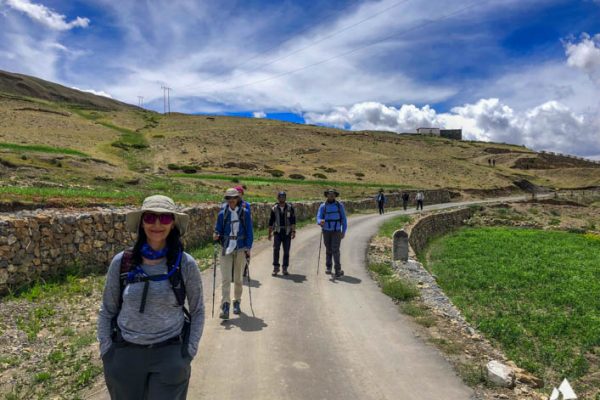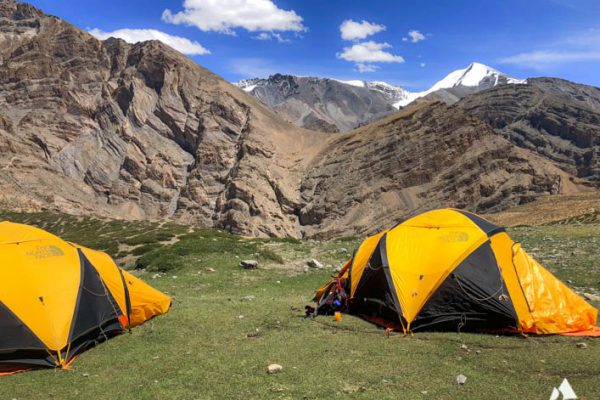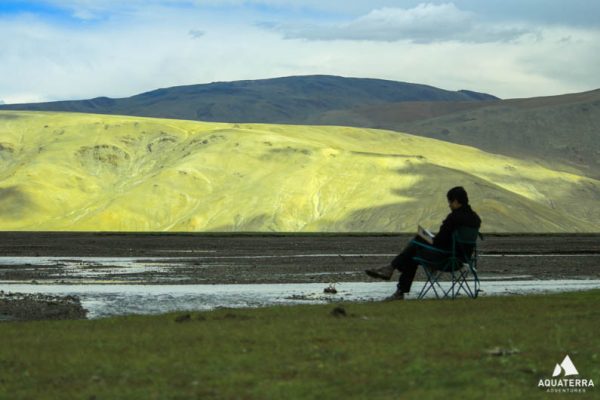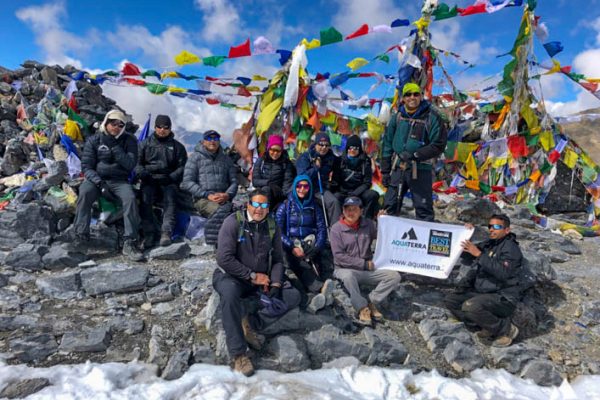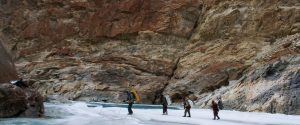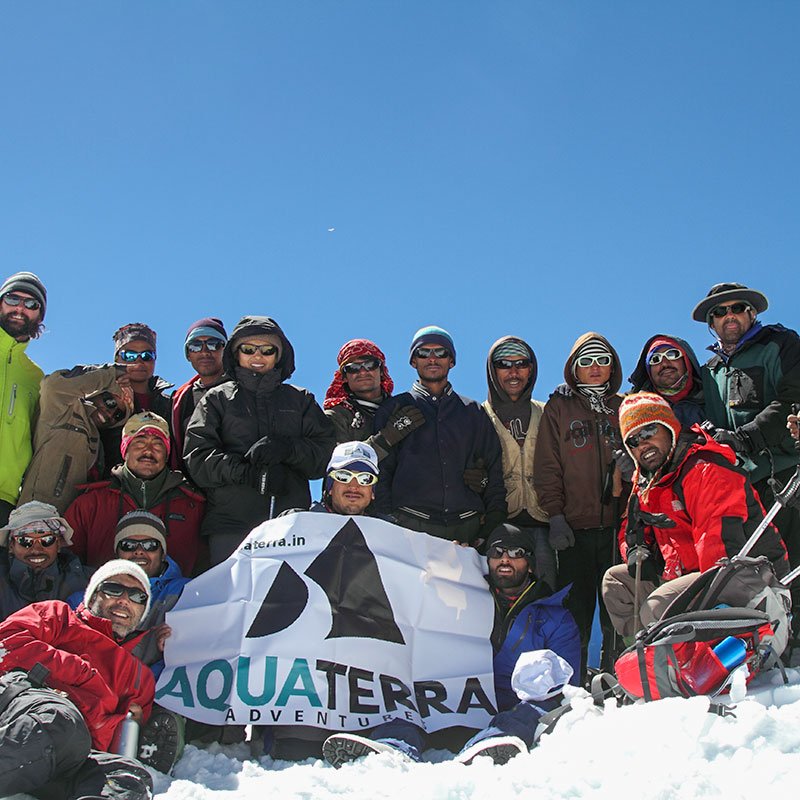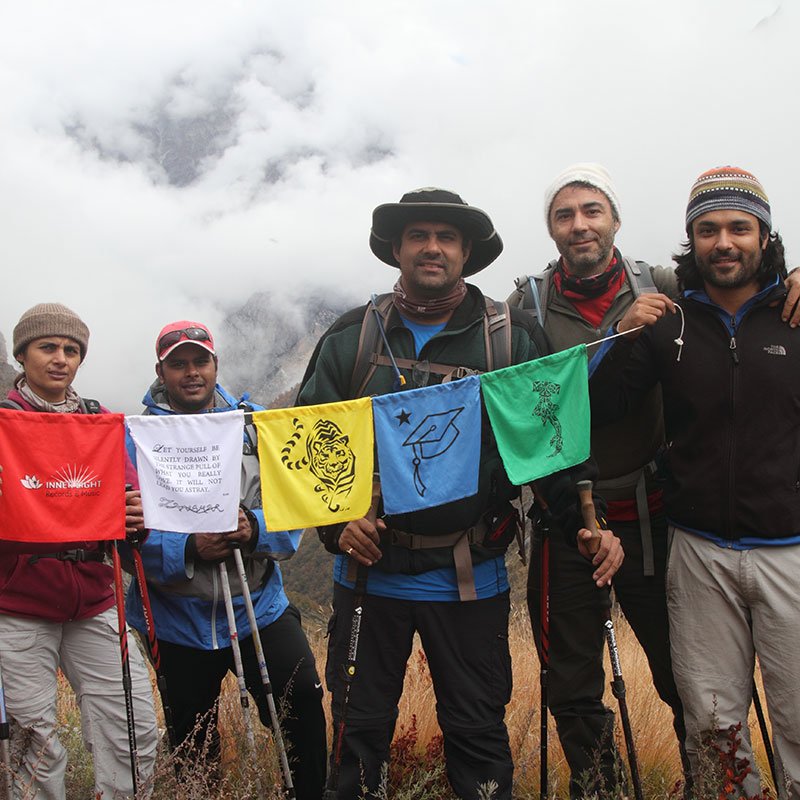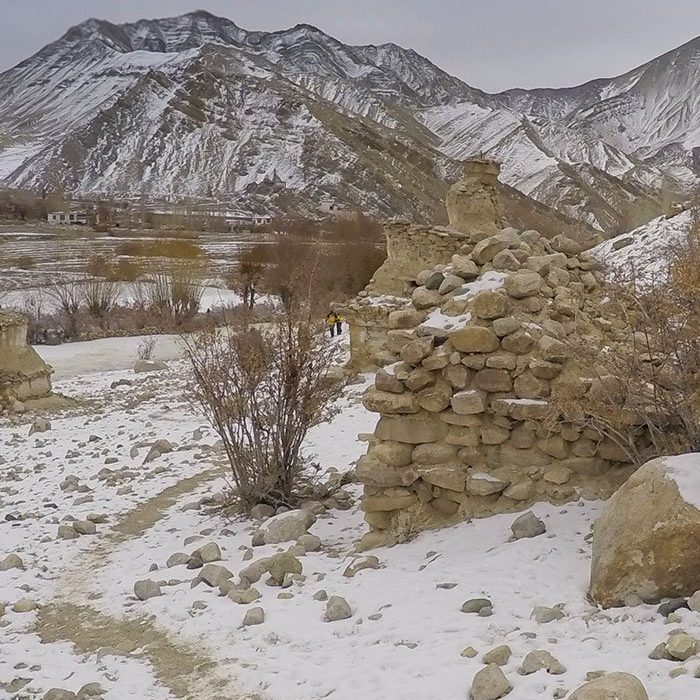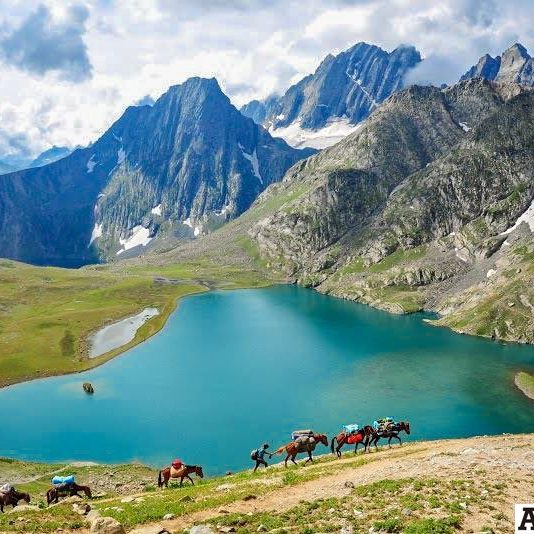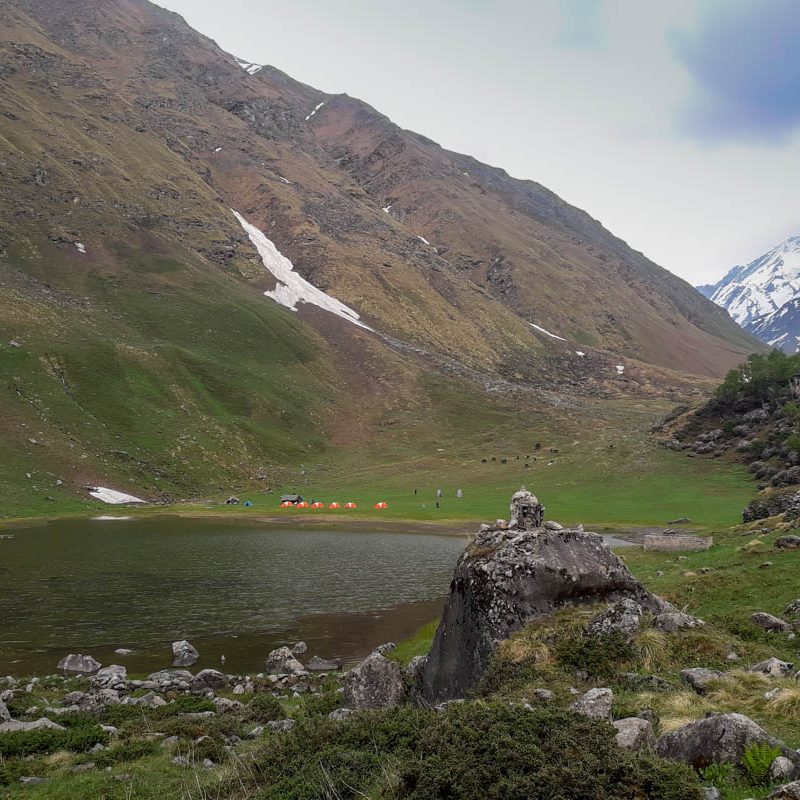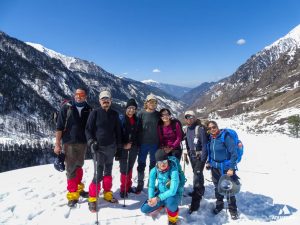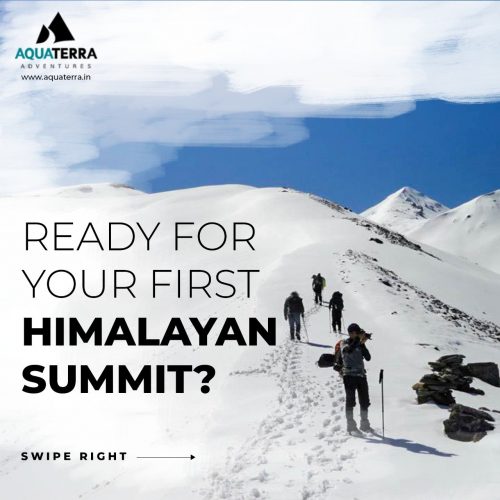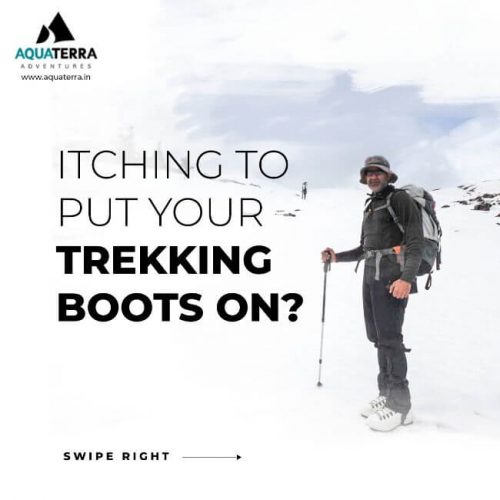An early start is mandatory the next morning, as the other side of the pass has heavy snow conditions. If one is lucky, a herd of sheep, who cross the pass with packs of barley strapped on to each of them, provide good company. The final gradient to the pass is extremely steep, and it takes a good couple of hours to finally haul oneself over the top. But once there, a complete change of terrain more than compensates for the lifetime it takes to climb over this 18,500-foot-high crossing. The pass on the Pare Chu side is snow-clad, and a broad valley greets you looking down towards the broad floodplain of the river.
There are a few well-camouflaged deep crevasses directly below the pass, which invariably claim a few sheep each year as they are shepherded over the “la.” Spiti horses are taken over to the Changthang side, where they are sold to the Changpas (nomads of Changthang) for money or pashmina in return. Sticking to the right of the pass on the descent, one crosses the Pare Chu at the mouth of the glacier over a not-so-stable snow bridge. The horses need to be coaxed here, as they invariably show a little reluctance while crossing what with the river raging a few feet below.
The advantage of starting this trip from Spiti is that, after the first few days of continuous ascent, the descent is fairly continuous for the next few days, though not entirely effortless, making the walk really enjoyable. The camp is set a few kilometers below the mouth of the river at Dak Karzong, a green meadow on the banks of the Pare Chu. A chance meeting with a traveler from Karzog is not ruled out, though they usually are in more of a hurry, going the entire distance in four days.
The river begins to divide itself over several channels now, and the valley is nearly a kilometer and a half wide. Crossing its many channels is part of the day’s work as we work our way downstream. The next two days are spent walking along the river through green meadows and wind formations (called “kathpa boozae”) not very many people have seen to date.
A week after having left Kibber, we reach the confluence of the Pare Chu with the Phirtse Phu at Norbu Sumdo. A river crossing here brings one to an almost incredible change of landscape as we walk north towards the Rupshu plains of Changthang. Camp for the night is at Chumik Shilale, a parrot-green meadow set in wide green plains and low, rolling, sun-kissed hills. From now on, spotting the Changthang wolf remains a very good possibility.
At Norbu Sumdo, we part company with the Pare Chu, which flows south from the confluence to flow into Tibet, past Chumur, India’s last outpost along its border with Tibet. Three years ago, I had visited Chumur as part of the first successful attempt to reach the base and make an attempt on Gya (6,794 meters), lying on the tri-junction of Tibet, J&K and Himachal Pradesh. Gya is also the highest mountain in Himachal Pradesh, a wonderfully elusive mountain and one of the finest rock-climbing challenges left. It had initially baffled a number of good-sized expeditions that tried to reach its base. Gya, or Kalcham Gyalmo, forms a grand backdrop as one walks away from Norbu Sumdo towards Karzog, remaining visible until we leave Karzog.
A few kilometers from Chumik Shilale lies Kiangdom, named after the abundance of Kiangs, the Tibetan wild ass found here. The walk toward Tso Moriri over a scree slope, with the lake and its delta visible, sends the adrenalin levels up as the enormity of the lake sinks in. Kiangdom lies at the southern edge of the Tso Moriri (15,000 feet), a high-altitude lake 27 kilometers long and nearly 8 kilometers wide. This lake is the breeding ground for the bar-headed goose, the black-necked crane, and the Brahminy duck.
Kiangdom needs to be visited in order to realize the immense beauty of this area, opened only in1994 to visitors.
The trail goes along the Tso Moriri until we reach Karzog, a permanent settlement and also the road ahead. The lake makes a fitting finale to a trek through landscape seemingly out of a picture postcard. A day or two spent here is a great idea since it allows visitors to take in the sights and sounds of the Buddhist way of life. Another worthwhile visit is to one of the Changpa settlements in a bowl high above Karzog, where this hardy people lives in yak-skin tents and breeds yaks and pashmina, one of the trade items to go over these high passes.
A four-hour drive from the Tso, passing through equally scenic terrain, lies Tsokar, a salt lake which was once the source of nearly all of Ladakh’s salt supply. The road climbs away from Karzog to Kiagar Tso, a smaller lake above Tso Moriri. According to locals, Kiagar Tso was part of the Tso Moriri until both receded. The motorable road passes through hot sulfur springs at Puga, which is well known for its healing powers, as several locals and people from Leh will gladly testify.
The dusty road climbs on to Polo Gonka, a small pass before the descent to the huge bowl of Tsokar. Large salt mounds litter the lake, and the water is expectedly extremely uncomfortable to taste. There is one convenient spot to camp next to a fresh water source on the banks of Tsokar. It is not surprising to see Kiangs run along and overtake the vehicle one is traveling in.
On the opposite bank from the campsite is the village of Tugche, which boasts of a massive wolf trap and an ancient monastery. From the monastery, one can see the watermarks of the lake, which at one time was nearly 200 to 300 feet higher than what it has presently receded to.
Four kilometers from Tsokar, one meets the main Manali-Leh highway before the climb to Taglang La, the world’s second-highest motorable pass. A comfortable four-hour drive away lies Leh, the capital of Ladakh, the highest and largest district in the country. It’s a fitting end to have experienced firsthand the enormous scale and the rugged, weather-beaten beauty of a region that remains much of a magical mystery and, for some of us, the end of a rainbow.
Getting There:
From Delhi: Fly/ Drive to Kullu. Drive on to Manali. Cross the Rohtang and take diversion at Gramphoo to Chattru. Continue on to Spiti via Batal, Kunzum La, Losar and Kaza. Kibber is two hours from Kaza.
Hire a jeep from Manali to Kibber. For self-driven vehicles, high suspension a must.
** A longer drive from Shimla to Kibber via Rampur, Kalpa, Tabo and Kaza is also a possibility**
Season
July to September (depending on the opening of the higher passes)
Travel Restrictions:
Permits for foreigners (minimum 04) required to be processed at DC Office, Kaza. Permits for Tso Moriri to be arranged to reach Karzog. Good acclimatization a must for this trip. Take at least three overnight stops between Manali and Kibber. Making arrangements through a reputed tour operator who will make all permit/transport arrangements, besides taking care of all trekking logistics, is recommended. Make sure you meet your trekking guide before you leave.
To join our yearly departure of Parang La, click here
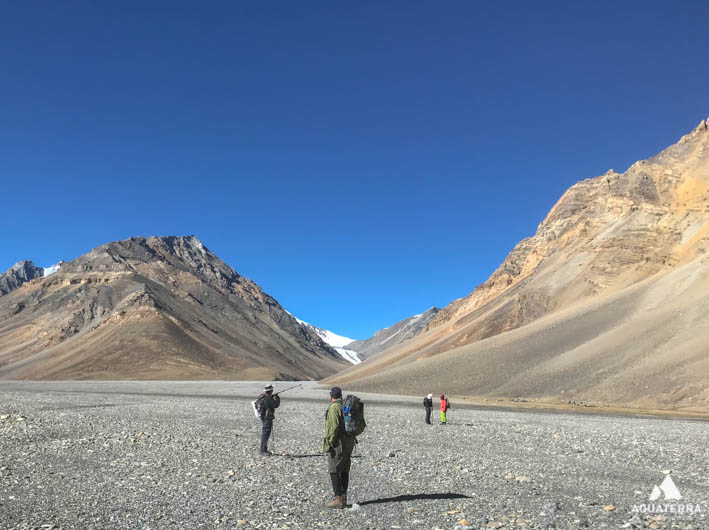
Parang La Trek in Leh-Ladakh
Where to Stay
PWD guest house at Chattru/ Set up your own Camp.
PWD guest house at Losar/ Set up your own Camp.
Kaza: Hotel Sakya’s Abode. Clean rooms with food available.
Kibber: Hotel Parang La. Setting up camp recommended.
Karzog – Set up your own camp.
Getting Out
Arrange transport to meet at Karzog for drive to Leh.
Fly Leh to Delhi.
Distances
Delhi-Manali (6,700 feet): 570kms
Manali-Chattru (11,670 feet): 79kms
Chattru-Losar (13,350 feet): 62kms
Losar-Kaza (11,800 feet): 58kms
Karzog-Leh (11,500 feet): 226kms
Article for: RealAdventures.com
About the Author: Vaibhav Kala is one of the most experienced outdoors people in India, having climbed and rafted extensively in his 12 years of experience. He has been part of major mountain attempts and some classic first descents of wild remote rivers in India’s northeastern state of Arunachal Pradesh. He now runs a successful outdoor outfit that provides safe, offbeat trips for the discerning traveler.



